·
She drew back; he was calm:
‘It is this that had the power.’
And he lashed his open palm
With the tender-headed flower.
He smiled for her to smile,
But she was either blind
Or willfully unkind.
He eyed her for a while
For a woman and a puzzle.
He flicked and flung the flower,
And another sort of smile
Caught up like fingertips
The corners of his lips
And cracked his ragged muzzle.
She was standing to the waist
In goldenrod and brake,
Her shining hair displaced.
He stretched her either arm
As if she made it ache
To clasp her – not to harm;
As if he could not spare
To touch her neck and hair.
‘If this has come to us
And not to me alone -‘
So she thought she heard him say;
Though with every word he spoke
His lips were sucked and blown
And the effort made him choke
Like a tiger at a bone.
She had to lean away.
She dared not stir a foot,
Lest movement should provoke
The demon of pursuit
That slumbers in a brute.
It was then her mother’s call
From inside the garden wall
Made her steal a look of fear
To see if he could hear
And would pounce to end it all
Before her mother came.
She looked and saw the shame:
A hand hung like a paw,
An arm worked like a saw
As if to be persuasive,
An ingratiating laugh
That cut the snout in half,
And eye become evasive.
A girl could only see
That a flower had marred a man,
But what she could not see
Was that the flower might be
Other than base and fetid:
That the flower had done but part,
And what the flower began
Her own too meager heart
Had terribly completed.
She looked and saw the worst.
And the dog or what it was,
Obeying bestial laws,
A coward save at night,
Turned from the place and ran.
She heard him stumble first
And use his hands in flight.
She heard him bark outright.
And oh, for one so young
The bitter words she spit
Like some tenacious bit
That will not leave the tongue.
She plucked her lips for it,
And still the horror clung.
Her mother wiped the foam
From her chin, picked up her comb,
And drew her backward home.
·
This poem puzzles me in a number of ways, and that’s probably because, as far as the poem goes, the reader isn’t quite sure what to make of either protagonist. On the one hand, the boy, or man,  is transformed into a beast with a “ragged muzzle”, “a hand hung like a paw”, and “a coward save at night”. On the other, Frost goes on to warn us that this is how the girl, or woman, sees him (and perhaps not how we should see him): “…what the flower began/ Her own too meager heart/ Had terribly completed. / She looked and saw the worst.”
is transformed into a beast with a “ragged muzzle”, “a hand hung like a paw”, and “a coward save at night”. On the other, Frost goes on to warn us that this is how the girl, or woman, sees him (and perhaps not how we should see him): “…what the flower began/ Her own too meager heart/ Had terribly completed. / She looked and saw the worst.”
On the subject of their age, I notice while reading what others have written, that the protagonists are frequently referred to as a man and a woman. Judith Oster, in her essay Frost’s Poetry of Metaphor, chooses to read the poem as an inexperienced girl and boy (seemingly ignoring the narrator’s own description of the “boy” as a “marred man”). Frost, though, makes a point of at least the girl’s youth, referring to her as “one so young”. I read that as meaning that she’s rightly called a girl. Usually when we refer to a teen-aged girl we refer to her as just that—a teen-aged girl—and not a teen-aged woman. So I’m going to refer to her as a girl, probably in her mid teens. Not too young for a boy or man’s (if we consider an eighteen or nineteen year old a man let’s say) amorous and physical affections.
Frost writes that “He eyed her for a while / For a woman”, but there’s hedging in that statement. “For a woman” suggests that maybe she really wasn’t. He wants to see her that way, he “eyed” her that way, but as the poem later suggests: she’s either not old enough to be eyed that way or she herself, if old enough, is too naive or immature. Both are suggested by the line: “A girl could only see/ That a flower had marred a man…” In other words, a woman might have understood, might have seen otherwise, but a girl could only see “a marred man”. So, my reading of their ages is that she’s probably younger than him in age, or at least younger than him in maturity and experience—or both.
- Frost’s own statement concerning the poem suggests an autobiographical element. That doesn’t mean he was portraying himself and Elinor (his wife), only that the poem might have been inspired by something, at some time, in their relationship. However, if one is going to argue that the poem is strictly autobiographical (which I wouldn’t), then Elinor and Robert would have been the same age.
Another cautionary thought would be this: be careful not to anachronistically appraise their relationship (such as it was or wasn’t). Liaisons between, say, a twenty year old “man” and a teen-aged “girl” were not considered grounds for statutory rape. On the other hand, while courting at this age was permissible, it was strictly proscribed. There might have been petting, if the couple was discreet in the extreme, but anything more could lead to considerable scandal, pregnancy and a shotgun wedding. So, my point would be: Don’t assume that the man was looking for sex. At the time Frost wrote this, and from the “girl’s” point of view, simply expecting a kiss (and a copped feel) might have been tantamount to sex (by her standards). Bottom line: don’t assume that the man was trying to “rape” the girl. That interpretation is available, but I would be wary of making it.
And that brings me to Frost’s own comment on the poem. I don’t think he would have made it if he had thought of the man as a potential rapist. In a 1960 Paris Review Interview he had this to say:
INTERVIEWER
[….}Another neglected poem, and an especially good one, is “Putting In the Seed.”
FROST
That’s—sure. They leave that sort of thing out; they overlook that sort of thing with me. The only person ever noticed that was a hearty old friend of mine down at the University of Pennsylvania, Cornelius Weygandt*. He said, “I know what that’s about.”
INTERVIEWER
Do you ever read that poem in public?
FROST
No, I don’t bother with those. No, there are certain ones. I wouldn’t read “The Subverted Flower” to anybody outside. It isn’t that I’m afraid of them, but I don’t want them out. I’m shy about certain things in my books, they’re more—I’d rather they’d be read. A woman asked me, “What do you mean by that ‘subverted flower’?” I said, “Frigidity in women.” She left.
So, if the point of the poem was to portray the man as a predator and the girl as a victim of sexual predation, then it strikes me as very unlikely (to put it mildly) that Frost would have characterized the poem’s subject (and by extension the girl’s behavior) as “frigidity”. Does this mean it’s all the girl’s fault?
Many readers have been content to perceive the man just as the girl perceives him—a depraved rapist in the making (seemingly ignoring the poem’s own warning). But the poem, like many of Frost’s best, is a Rorschach test. Readers tend to read it in their own image. For example, if you do a search for “Subverted Flower” on the internet, one of the links cited will be a Masters Degree thesis written in 1958 by a John Thomas Trahey. Interestingly, Trahey’s Master’s Thesis was written while Frost still lived and before Frost’s comment in the Paris Interview:
The poem “The Subverted Flower” is an instance of what Frost thinks of men who try to lead others into sexual sins. In the poem an adolescent boy tries to lead an adolescent girl into fornication. It is interesting to note that Frost keeps referring to the boy as if in his sexual habits he were a dog. It is evident Frost despises this sort of thing as fit only for brutes… [Trahey p. 32]
The PDF’s introductory notes reveal that Trahey attended St. Ingatius High School, then went on to the Milford Novitiate of the Society of Jesus in Milford, Ohio, and then the Jesuit Philosophate at West Baden College. Notice a trend? Trahey was primed, by a rather religious environment, to read Frost’s poem as an indictment of “sexual sin”. Trahey was entirely wrong about “what Frost thinks” and utterly missed Frost’s warning, but it’s interesting in that it reflects a not uncommon reading of the poem.
But what about the opposite reading. Is it all the girl’s fault? It might be a little unfortunate that Frost commented on the poem. Yeats always refused to do so and Frost was normally cagey or took a mischievous delight in leading readers down the primrose path. I take Frost at his word though; but I’d assert that his comment doesn’t make the man any less ambiguous. The girl may be frigid, but I don’t think Frost means us to discount her perception of the man as a kind of inarticulate brute.
Lines 1-4
She drew | back; he | was calm:
“It is this | that had | the power.”
And he lashed| his o|pen palm
With the ten| der-hea|ded flower.
The underlying meter of the poem is iambic trimeter though the opening quatrain isn’t regular enough to establish it. There are too many variant feet. I read the first two feet of the first line as spondees. The next three lines begin with anapests. The reader’s ear has nowhere to land. At this point in his career Frost had already proven that he could write perfect iambics and had shown a willingness to run the colloquial expression against the grain of the meter. The effect of the unsettled meter could also be understood as underscoring the unsettled drama and emotions that open the poem. That is, the reader finds themselves in the middle of something that is already underway.
The girl draws back. The man lashes his open palm with the tender-headed flower. What has happened?
My own reading is that the girl has just given the flower to the man but something he’s done and/or said makes her ‘draw back’. We find ourselves in the middle of an argument. He says to her, as if in answer to a question or accusation: “It is this that had the power”. We can’t be certain that he’s referring to the flower, but it’s hard to not draw that conclusion.
What does he mean?
The use of the word power in reference to the flower (or any flower) is a strange collocation. The power of the flower is obviously symbolic. One might imagine that the girl asked: “What changed you?” Her erstwhile harmless companion is unrecognizable. To which the man answers: “It is this that had the power”. The flower was a kind of invitation and, like the petals of the flower, suggested an opening and awakening. But it’s evident that he has entirely misread the girl’s intentions. She, like the flower, is tender-headed; and his all too masculine eagerness and impulsiveness is destructive. He lashes it in his open palm, a likely metaphor for the insensibility of his sexual impulses. In these four lines, then, the entirety of the poem is captured.
Lines 5-14
He smiled | for her | to smile,
But she | was ei|ther blind
Or will|fully |unkind.
He eyed |her for |a while
For a wo|man and |a puzzle.
He flicked |and flung |the flower,
And ano|ther sort |of smile
Caught up |like fing|ertips
The cor|ners of |his lips
And cracked |his rag|ged muzzle.
The next 10 lines reveal the man’s own confusion, then a kind of resolve. A hostile confrontation isn’t what the man intended. He smiles for her to smile, but she is either blind or willfully unkind. The fault seems to lie with the girl. Or does it? I think the lines are best understood not as reflecting the narrator’s observations but those of the protagonist. It’s the man who is confused and concludes that she’s either ignorant (blind is an accusatory description—as though she ought to know) or malicious (willfully unkind). It doesn’t seem to occur to him that she might be too young or inexperienced, or that her interests might not be sexual. He eyes for a woman; and for that reason, perhaps, as a puzzle. In other words: What did she mean by giving him a flower if it wasn’t an overture? If a girl gives a man a flower, there’s no confusion, but if a woman does so?
He flicked and flung the flower,
And another sort of smile [caught up his lips]…
A decision is made. He might have apologized, but instead, as I read it, he concludes that she’s simply naive or innocent. He can forgive innocence. He doesn’t eye her as a woman any more, but as a girl. And he’ll explain himself. The narrator takes us in and out of both their perceptions. She sees his smile as one “caught up like fingertips”—false, deceptive and disingenuous—transformed into a ragged muzzle. He, on the other hand, sees her not as a woman, but as a girl:
She was stan|ding to| the waist
In gol|denrod |and brake,
Her shi|ning hair |displaced.
He sees in her the very picture of innocence. Only by her hair being “displaced”do we know that something is awry. This is not a perfect picture.
Lines 18-29
He stretched |her ei|ther arm
As if |she made |it ache
To clasp |her – not |to harm;
As if |he could |not spare
To touch |her neck |and hair.
“If this |has come| to us
And not |to me| alone -”
So she thought |she heard| him say;
Though with ev|ery word |he spoke
His lips |were sucked |and blown
And the ef|fort made| him choke
Like a ti|ger at |a bone.
He ‘stretches her either arm’, and by this I think the narrator means that he’s taken her hands in his (having just flicked the flower away). In a sense, he means to trade one tender-headed flower for another, but the girl isn’t so tender-headed as to miss the meaning in the flicked and flung flower. She won’t be the next one flicked and flung aside. Her perception of the man continues to disfigure him. If the man’s intention is to awaken her (or possibly seduce) and by this means make of her a woman, the effort both succeeds and backfires. That is, the woman she’s becoming isn’t the woman he intended.
He holds her hands, stretching her arms, when what he really wants is “to touch her neck and hair”. He then makes the somewhat opaque comment: “If this has come to us/And not to me alone -” Which I read as meaning: ‘If our affection is mutual, and not mine alone -‘ But even here we can’t be sure: this is only what she thought ‘she heard him say’. The interaction falls further and further into ambiguity. Her perception of him continues to transform him into a kind of Caliban-like beast, only half-capable of speech—an effort at dignity that makes him choke “like a tiger at a bone.”
Lines 30-34
She had| to lean| away.
She dared |not stir| a foot,
Lest move|ment should| provoke
The dem|on of |pursuit
That slum|bers in |a brute.
She freezes, and the psychological astuteness of Frost’s writing holds its own into the 21rst century. Consider the following Washington Post article:
…if the fear circuitry perceives escape as impossible and resistance as futile, then not fight or flight, but extreme survival reflexes (which scientists call “animal defense responses”) will take over. These can activate automatically when the body is in a predator’s grip – and when, as half of rape victims report, we fear death or serious injury. ¶ One such response is tonic immobility. In freezing, brain and body are primed for action. But in tonic immobility, the body is literally paralyzed by fear – unable to move, speak, or cry out.
What Frost is describing is a reaction that is pertinent to our modern day discussions of rape and sexual abuse. Again, none of this to say that Frost intended us to read the poem as attempted rape (or that the girl was truly in that kind of danger). It is to say, though, that this is how the girl felt; and that Frost beautifully captures it. She had to lean away, but she didn’t. She was too afraid.
Lines 35-40
It was then |her mo|ther’s call
From inside| the gar|den wall
Made her steal| a look| of fear
To see |if he| could hear
And would pounce| to end| it all
Before |her mo|ther came.
That her mother is so close by doesn’t mean she isn’t (or couldn’t be) in danger, but does suggest that her fears (and reaction) might be disproportionate. That her mother is calling also suggests her youth.
Lines 41-49
She looked| and saw| the shame:
A hand |hung like| a paw,
An arm |worked like |a saw
As if |to be| persuasive,
An ingra|tia|ting laugh
That cut |the snout| in half,
And eye| become |evasive.
A girl |could on|ly see
That a flower| had marred| a man,
These next lines place us fully in the girl’s realm of perception. “She looked and saw the shame”, but whether it’s really ‘shame’ or simply disappointment (or some other emotion) is left to the reader to decide. The poem is nothing if not a reenactment of wrong assessment, misreading and misunderstanding. Frost may let us into the minds of the protagonists, but only to reveal their mutual confusion. The girl, after all, has fully transmogrified the man. He’s a brute now—a beast whose hand hangs like a paw. The reference to his arm working like a saw is an unmistakable reference to masturbation. Is he really? She may perceive it that way but I think it’s more likely he gestures her to follow him. That said, her interpretation, and his ultimate intention, may not be that far from the mark. But what of it? I think it was Oscar Wilde who said: “There are two kinds of people in the world: Those who masturbate and those who lie about it.”
And what harm in sexual pleasure (which doesn’t have to imply intercourse)? It’s at this juncture that Frost’s own comment on the poem is either considered or ignored. Contrary to John Trahey’s assertion, that the poem ” is an instance of what Frost thinks of men who try to lead others into sexual sins”, Frost’s own judgment is that she’s being “frigid”, defined as: “sexually unresponsive; “was cold to his advances”; “a frigid woman”. This would suggest that Frost (as opposed to the narrator) isn’t entirely sympathetic with the girl.
But setting Frost’s own comment aside, the line suggests that the girl herself isn’t unfamiliar with masturbation. Why else make the observation that his hand “worked like a saw”? She could have simply said that he gestured her to follow. She doesn’t. She seems to compare it to masturbation. A reader might fairly conclude she isn’t altogether as innocent as appearances suggest. If this adds another layer of confusion to the poem (and we, as readers, like to ultimately know one way or the other) so be it. Sometimes in sexual matters like these, there’s no pat answer. Is he/she right? Wrong? Who’s to blame? Maybe both. Maybe neither. Then as now, questions of rape, responsibility and consent remain difficult to sort out.
The narrator remarks: “A girl could only see/That a flower had marred a man…” suggesting that a woman might have understood the gesture, might have seen otherwise. The lines also suggest that there was another way she might have “seen him”, as other than a “marred man”. The narrator continues:
Line 50-56
But what |she could| not see
Was that |the flower |might be
Other |than base |and fetid:
That the flower| had done| but part,
And what |the flower| began
Her own |too mea|ger heart
Had ter|ribly |completed.
The narrator suggests the girl had other options and by doing so the reader is invited to conclude that the misunderstanding (the fault) is the girl’s. A feminist critique might fairly argue that there’s implicit misogyny in that assertion, though misogyny might not be the right word. Entitlement? Why should the man be entitled to the girl’s sexual favors? Why shouldn’t it be within her rights to reject him? What other options did she have? Was there some middle ground?
Lines 57-68
She looked |and saw| the worst.
And the dog |or what| it was,
Obey|ing best|ial laws,
A cow|ard save| at night,
Turned from| the place| and ran.
She heard| him stum|ble first
And use |his hands| in flight.
She heard |him bark| outright.
And oh, |for one| so young
The bit|ter words |she spit
Like some| tena|cious bit
That will |not leave| the tongue.
All we know as that she looked and “saw the worst”. The man/dog, provoked by sexual interest is doing nothing more than “obeying bestial laws”. If there’s any autobiography in the poem, I find it here. If nothing else about the poem is autobiographical, the contemptuous accusation that a man’s interest in sex is nothing more than “obeying bestial laws” has the ring of truth, of a real accusation likely to be made when one partner’s sexual desire exceeds the others. After a time, the incessant demand for sex can feel like “pawing”. We’ll never know, but it’s likely (in my opinion only) that Frost’s sexual appetite exceeded Elinor’s. And I wouldn’t be surprised if at some point she was fed up with him. To be fair there was the added complication of pregnancy. There weren’t birth control pills. Elinor had already had four children, wasn’t exactly living an easy life, and probably wasn’t game to risk another pregnancy for the sake of Mr. Robert Frost. More generally, the poem could also reflect a lifelong difference in their attitudes toward sex and desire for sex, beginning when they were first courting; and Frost may have vented some of that frustration in the poem. If so, was it fair to call her frigid? Maybe. Maybe not. If Elinor had written the poem though, the conclusion might have been a little different.
- The likelihood that Frost’s sexual desires exceeded his wife’s finds some backing in the biography of Lawrence Thompson. In his book, Robert Frost Handbook, by Pittman B. Potter, Potter writes: “We should not be surprised to learn that the poem reflects an episode in Frost’s early courtship of Elinor White. Thompson has shown that their relationship was seriously disturbed by Elinor’s very shy reaction to Frost’s physical passion, and Frost’s resentment reflects itself in the subtle slanting here in the boy’s favor.” [p. 63]
The lines “obeying bestial laws,/ A coward save at night…” once again hints at masturbation and the girl’s own dark familiarity with it’s pleasures and its “cowardice”. And it’s at this turn that the girl’s own transformation begins, when she “for one so young” spits the words that will not “leave her tongue”. Like her suitor, she’s also transformed into a Caliban-like beast only half-able to speak. And it’s this moment that’s the most fascinating and revealing in the poem. Not only is he transformed into a beast by his misapprehension and hers, but the girl too. Her own sexual energy, like the flower, is subverted, channeled into divisiveness rather than union, contempt rather than acceptance, hatred rather than love. Subvert has the meaning: “To pervert, as the mind, and turn it from the truth; to corrupt; to confound.” The girl’s sexuality is turned upside down and made as bestial as his.
Line 69-73
She plucked| her lips |for it,
And still |the hor|ror clung.
Her mo|ther wiped| the foam
From her chin,| picked up| her comb,
And drew |her back|ward home.
Her mouth foams, and the reader might be reminded of a rabid dog. While one dog runs away, the other dog barks, foaming at the mouth. Both lovers are metamorphosed by the subversion of the flower. One might assert that because she refuses to be the flower, the man is transformed into a beast, but I think this ignores the girl’s own culpability and transformation. She may be young, but the narration more than suggests that she’s not entirely innocent.
And while all the lines offer moments of revelation, the last is the most suggestive. The girl must be drawn “backward” home. She doesn’t flee when given the chance. Her own sexuality, albeit subverted, is awakened and as engaged as the man’s, compelled by the same bestial laws and as drawn to the engagement (despite her foaming denial). Her mother’s forceful intervention draws her home but the girl won’t be disengaged. The flower’s “power”—sexual awakening—as inevitably draws and overwhelms the girl as it does the man.
“The mother’s call had issued from the safe domestic world—”From inside he garden wall”—and she is taken back out of threateningly sexualized nature and into that refuge at the poem’s end. [….] ¶ [But] to be drawn is not to be dragged, and yet “backward” shows no great willingness. The poem ends with a subtle variation on where it began: “She drew back; he was calm.” Now, she must be drawn back, and all sense of calm has gone, to be replaced by a fallen “comb” which is a symbol of the struggle.” [p. 373]
That the mother wipes the girl’s chin and picks up her comb suggests the mother’s infantilizing. The comb might be understood as the girl’s girlhood. The girl’s hair, that has been ‘displaced’ by her sexual encounter with the man, will be straightened. In other words, the infantilizing comb, which has been tellingly forgotten by the girl, will comb out and remove (presumably by the mother) any record of the encounter.
Fairly or unfairly, the narrator portrays the girl as not just condemning the man’s/boy’s sexual advances, but also condemning her own (this through her suggested knowledge of masturbation and sexual desire). The tragedy is that rather than elevating them both, they’re both metamorphosed into something bestial—the subversion of what should be good and beautiful.
- A note on the rhyme: I may return to this post to discuss the rhyme scheme, which isn’t regular but masterfully handled. The rhymes of puzzle and muzzle are beautifully handled in the sense that muzzle follows only after several lines. The reader subliminally waits and when muzzle does appear it’s all the more effective. Also worth noticing is the rhyme of the last three lines, a way to conclude the poem and bring it to a more final stop. (Elizabethan playwrights would sometimes use a concluding couplet to signal the end of a speech.) As in After Apple Picking, the rhyme scheme’s irregularity allows Frost to deploy them in a way that adds emphasis to the narration. The meter, as mentioned above, is Iambic Trimeter varied, principally, by anapestic first feet and feminine endings.
And that, for now, is that. Let me know if you enjoyed or have questions.


 two part base line that is itself a two part cannon—a contrapuntal tour-de-force, worthy of Bach, well in advance of any other known medieval song. The song dates from the mid 13th century. The lyrics are also a fine example of early English poetry. This was before Chaucer and before any known examples of blank verse or Iambic Pentameter. The song is also unique in being the earliest surviving song that is secular rather than sacred.
two part base line that is itself a two part cannon—a contrapuntal tour-de-force, worthy of Bach, well in advance of any other known medieval song. The song dates from the mid 13th century. The lyrics are also a fine example of early English poetry. This was before Chaucer and before any known examples of blank verse or Iambic Pentameter. The song is also unique in being the earliest surviving song that is secular rather than sacred.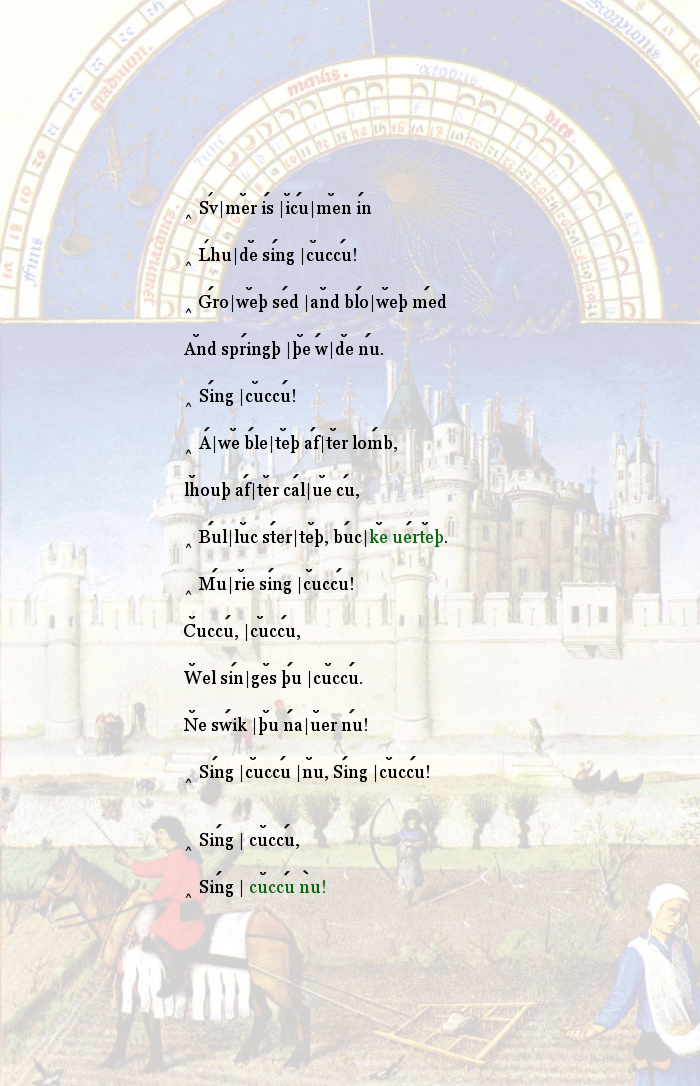
 I think this latter scansion is less likely. But what does ‘likely‘ mean? Whether we treat the first syllable as headless or as the start of a cretic foot makes no difference as far as performance goes. I guess I would put it this way: Prosodists like to be able to identify a basic metrical pattern (if there is one). In this case, I suppose, it’s easier to say that the song’s basic meter is Iambic Trimeter—with variations; but the variations are so numerous as to make any regular metrical pattern arbitrary. The poem is iambic trimeter here, tetrameter there, and then dimeter. Two feminine endings are marked in green. It is what it is; and wasn’t meant to be a poem with a regular metrical pattern. So, take your pick. A headless foot implies less of a deliberate design, I suppose, than a cretic foot. And there are other ways to scan this poem, but the top scansion strikes me as the simplest.
I think this latter scansion is less likely. But what does ‘likely‘ mean? Whether we treat the first syllable as headless or as the start of a cretic foot makes no difference as far as performance goes. I guess I would put it this way: Prosodists like to be able to identify a basic metrical pattern (if there is one). In this case, I suppose, it’s easier to say that the song’s basic meter is Iambic Trimeter—with variations; but the variations are so numerous as to make any regular metrical pattern arbitrary. The poem is iambic trimeter here, tetrameter there, and then dimeter. Two feminine endings are marked in green. It is what it is; and wasn’t meant to be a poem with a regular metrical pattern. So, take your pick. A headless foot implies less of a deliberate design, I suppose, than a cretic foot. And there are other ways to scan this poem, but the top scansion strikes me as the simplest. is transformed into a beast with a “ragged muzzle”, “a hand hung like a paw”, and “a coward save at night”. On the other, Frost goes on to warn us that this is how the girl, or woman, sees him (and perhaps not how
is transformed into a beast with a “ragged muzzle”, “a hand hung like a paw”, and “a coward save at night”. On the other, Frost goes on to warn us that this is how the girl, or woman, sees him (and perhaps not how 

















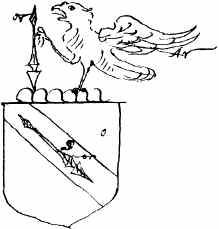

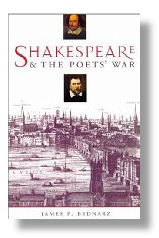






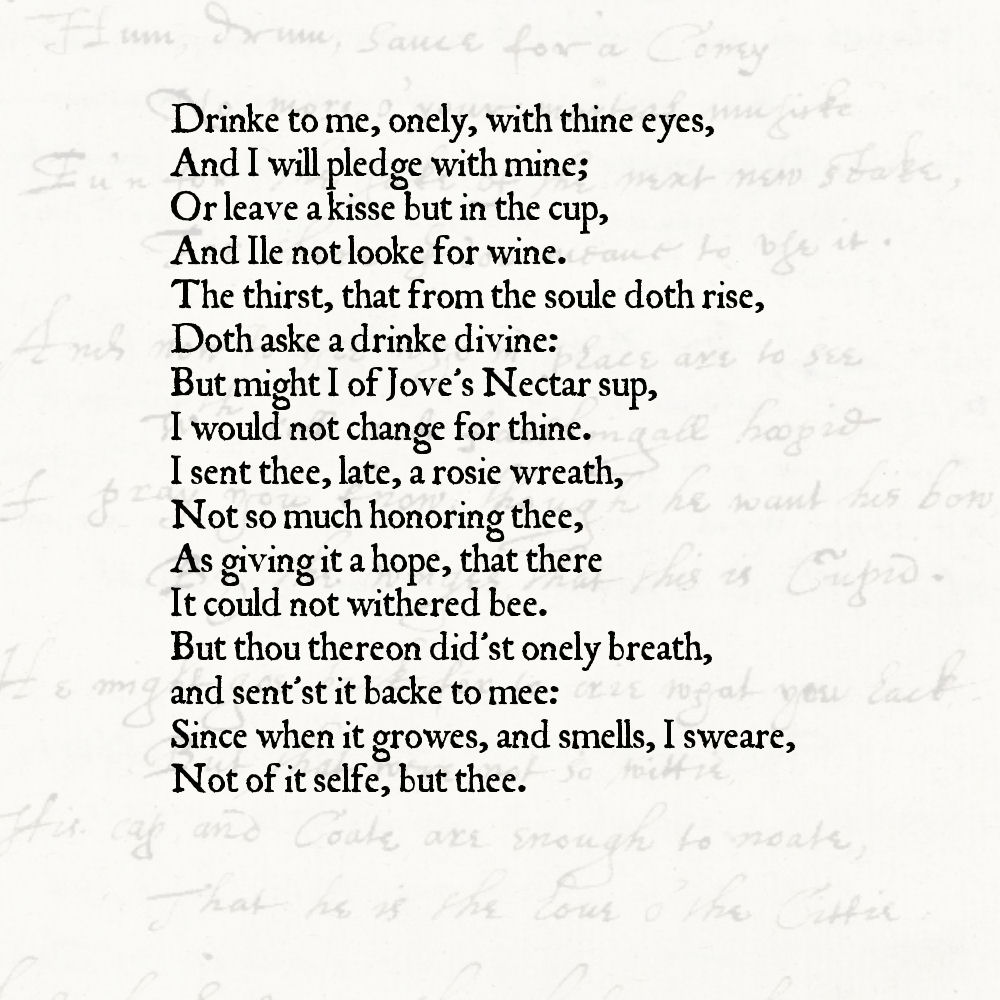






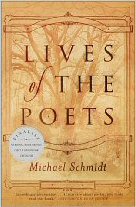




 In either case, the meter disturbingly echoes the slap of his father’s palm on the boy’s head, disrupting the meter of the poem, the waltz, and any joy the boy takes in the father’s drunken attention. The only real anapestic variant in the poem occurs in the second line of the poem’s final stanza – with a palm. Though I shy away from giving poets too much credit for qualities (such as vowel & consonant sounds) inherent in the English language, I think that Roethke’s anapest, in this stanza, was deliberate. He could have written – With palms|cracked hard| by dirt. I think the line would have worked that way. My reading is that the anapest nicely reproduces the hard, swinging whack of the father’s palm on the boy’s head.
In either case, the meter disturbingly echoes the slap of his father’s palm on the boy’s head, disrupting the meter of the poem, the waltz, and any joy the boy takes in the father’s drunken attention. The only real anapestic variant in the poem occurs in the second line of the poem’s final stanza – with a palm. Though I shy away from giving poets too much credit for qualities (such as vowel & consonant sounds) inherent in the English language, I think that Roethke’s anapest, in this stanza, was deliberate. He could have written – With palms|cracked hard| by dirt. I think the line would have worked that way. My reading is that the anapest nicely reproduces the hard, swinging whack of the father’s palm on the boy’s head.
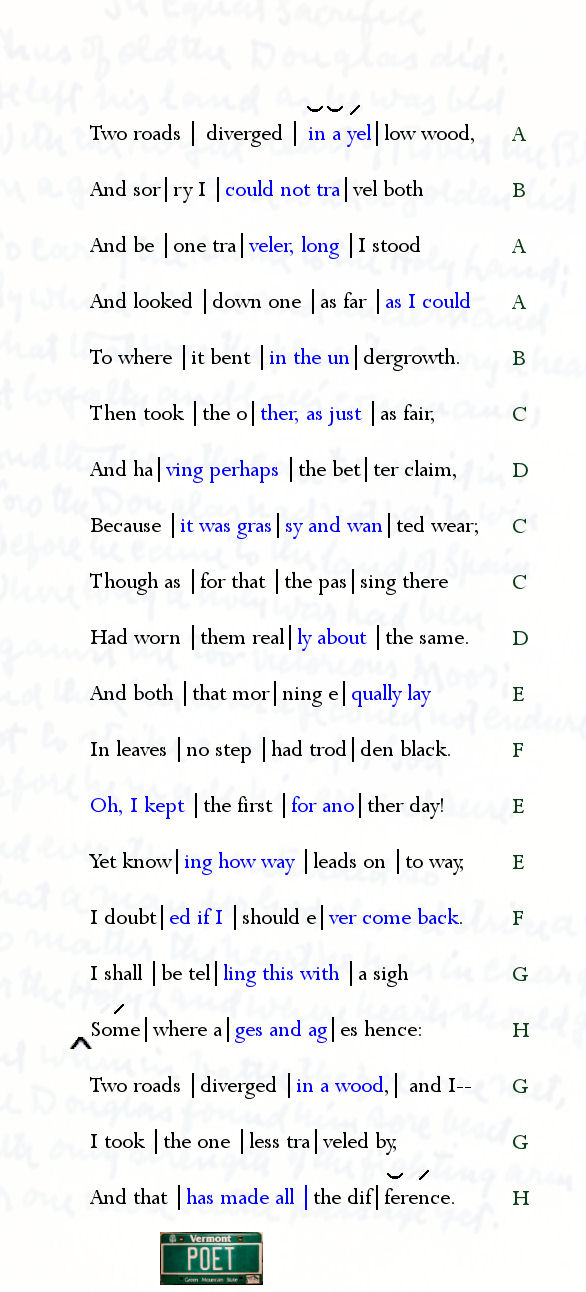
 The first three lines, metrically, are alike. They seem to establish a metrical pattern of two iambic feet, a third anapestic foot, followed by another iambic foot.
The first three lines, metrically, are alike. They seem to establish a metrical pattern of two iambic feet, a third anapestic foot, followed by another iambic foot. This is not an unreasonable way to scan the poem – but it ignores how Frost himself read it. And in that respect, and only in that respect, their scansion is wrong. Furthermore, even without Frost’s authority, their reading ignores Iambic meter. Frost puts the emphasis on trav-eler and so does the meter. Their reading also ignores or fails to observe the potential for elision in trav‘ler which, to be honest, is how most of us pronounce the word. A dactyllic reading is a stretch. I think, at best, one might make an argument for the following:
This is not an unreasonable way to scan the poem – but it ignores how Frost himself read it. And in that respect, and only in that respect, their scansion is wrong. Furthermore, even without Frost’s authority, their reading ignores Iambic meter. Frost puts the emphasis on trav-eler and so does the meter. Their reading also ignores or fails to observe the potential for elision in trav‘ler which, to be honest, is how most of us pronounce the word. A dactyllic reading is a stretch. I think, at best, one might make an argument for the following:

 The second quintain’s line continues the metrical pattern of the first lines but soon veers away. In the second and third line of the quintain, the anapest variant foot occurs in the second foot. The fourth line is one of only three lines that is unambiguously Iambic Tetrameter. Interestingly, this strongly regular line comes immediately after a line containing two anapestic variant feet. One could speculate that after varying the meter with two anapestic feet, Frost wanted to firmly re-establish the basic Iambic Tetrameter pattern from which the overal meter springs and varies.
The second quintain’s line continues the metrical pattern of the first lines but soon veers away. In the second and third line of the quintain, the anapest variant foot occurs in the second foot. The fourth line is one of only three lines that is unambiguously Iambic Tetrameter. Interestingly, this strongly regular line comes immediately after a line containing two anapestic variant feet. One could speculate that after varying the meter with two anapestic feet, Frost wanted to firmly re-establish the basic Iambic Tetrameter pattern from which the overal meter springs and varies.
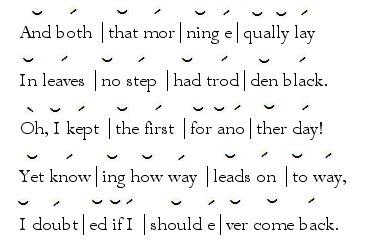

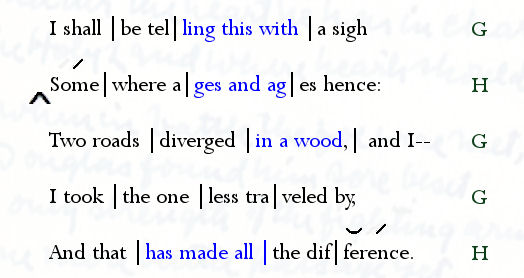

 Emily Dickinson possessed a genius for figurative language and thought. Whenever I read her, I’m left with the impression of a woman who was impish, insightful, impatient, passionate and confident of her own genius. Some scholars portray her as being a revolutionary who rejected (with a capital R) the stock forms and meters of her day.
Emily Dickinson possessed a genius for figurative language and thought. Whenever I read her, I’m left with the impression of a woman who was impish, insightful, impatient, passionate and confident of her own genius. Some scholars portray her as being a revolutionary who rejected (with a capital R) the stock forms and meters of her day.







